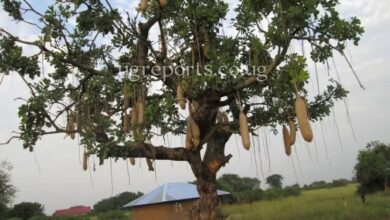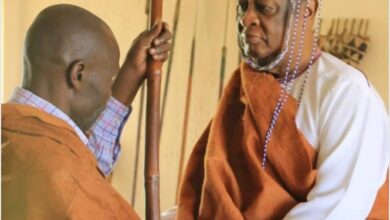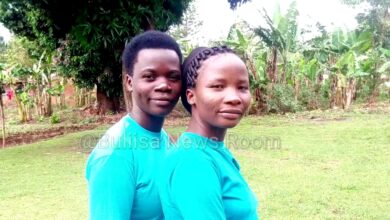What you didn’t know about the Polish Church in Masindi
The Polish refugees are regarded as the pioneers of Nyabyeya Forestry College, the only forestry college in East Africa by then.
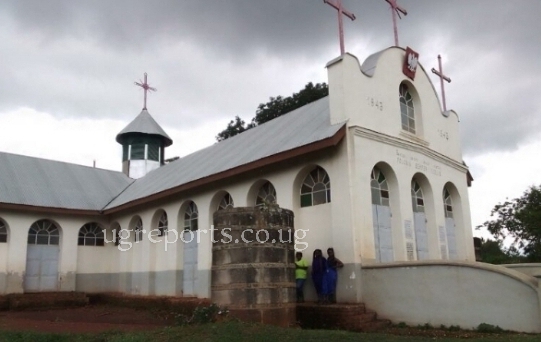
Masindi: Nestled on the edges of the lush tropical Budongo forest in Nyabyeya village, 35km from Masindi town, is an 84-year-old Catholic church.
The church stands at the foot of a small hill called Wanda in a T structure, typical of a classic Catholic church, with a cross towering over the minaret at the intersection of the T structure and three others atop the main entrance, while the other two crosses rest on the left and right sides.
Above the church entrance is the Polish coat of arms with the inscription Poloniae semper Fidelis (Poland is always faithful). On the exterior is another inscription in four languages: Polish, English, Latin, and Swahili, saying: “This church is dedicated to the Blessed Virgin Mary, Queen of the Polish Crown, built by Polish exiles while wandering to the free Fatherland.”
Inside the church is an icon of Our Lady of Częstochowa hanging above the altar and paintings of stations of the Way of the Cross with Polish inscriptions on the walls.
This church is an anomaly both architecturally and culturally; save for minor renovations like the walls painted in white and gray, it still has its original compositions, like the hard-carved wooden pews, stained glass windows, towering wooden sculpture of Jesus carved from a single tree trunk, most likely mahogany, altar ornaments, and a floor made of handmade hexagonal bricks.
A quick tour around the church brings questions to mind, like, Who built this church? What is the history behind it? Why are there so many Polish inscriptions and iconography all over it?
According to Father Peter Wasswa, the priest at the church and the country director of the Polish Organization in Uganda, the church was built between 1943 and 1945 by Polish refugees who had fled Poland because of World War II.
In 1939, 2000 Polish women, children, and elderly men arrived in Masindi. The number had risen to 3,200 by 1944, of whom 1,528 were children and only 267 men, most of whom were either old or unwell. Healthy men were away at war.
While here, the Poles started praying under trees and on hills due to the lack of a proper church. This made them think of building their own church in honor of the Blessed Virgin Mary, crowned Queen of Poland. Amazingly, this piece of architecture, which still stands strong today, was built almost entirely by women; the elderly men only gave advice.
“Slowly, [the women] started laying bricks and getting timber from Budongo forest by themselves for building the church, and up to today, it is still intact, apart from the roof, which was changed,” Fr. Wasswa says.
Gazetted by the Ugandan government six years ago as a heritage site called Nyabyeya Heritage Site, visitors are frequently amazed to learn that the area was once home to a community of Poles. The church now takes the name ‘Our Lady Queen of Poland Catholic Church’ and is being run under the diocese of Hoima.
“We are still preserving it up to date, and the locals pray for it. Most people around here are also refugees from the DRC; so, the common language used even during prayers is Kiswahili,” Wasswa says.
The cemetery
Adjacent to the church is a cemetery with 60 graves, of which 44 are for Polish nationals, which is enclosed in a low fence with a small gate and a plaque with inscriptions in Polish that translate: “Let us pray for the deceased Poles 1939–1947’.
Fr. Wasswa says upon arrival in Nyabyeya, the Poles found a thick forest, and many of them never survived because of the weather, tropical diseases, and lightning that struck some of them. One of the people buried there was reportedly the aunt of the late Pope John Paul II, whose relatives came and confirmed her grave.
In 2010, the cemetery was renovated by students from the Pedagogical University of Kraków in Poland. The maintenance and renovation work was financed by Poland’s Ministry of Culture and National Heritage under the Sites of National Remembrance Abroad program. To this day, descendants of Poles who once called Nyabyeya home still visit the site to pay their respects.
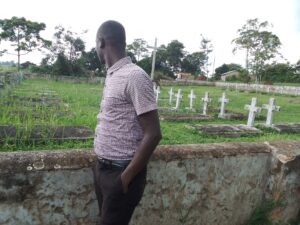
The coming of the Polish refugees
In 1939, approximately 2,000 Polish refugees fled Europe and arrived in western Uganda. These were part of 17,000 Polish citizens given asylum in British East African colonies.
The Nairobi-based East African Refugee Administration made arrangements for their settlement in East Africa, while the Polish government took responsibility for transporting them and establishing settlement camps.
The first group of 492 Polish refugees arrived in Uganda by train from Kenya on September 8, 1942, three years after they had fled Poland. They disembarked at Namasagali. From here, the refugees boarded barges that took them down the Nile to Masindi, from where they were transported by trucks to Nyabyeya, 35km from Masindi town, and were welcomed by Tito Gafabusa Winyi IV, who was the Omukama of Bunyoro.
Uganda had offered refuge to at least 6,200 Polish refugees by 1944 at two settlements in Masindi and Kojja in Mukono. By March 1944, the Masindi settlement had 3,200 refugees.
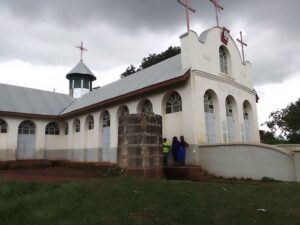
The settlements
According to Ritah Karungi, the Masindi district tourism officer, the Poles ended up in the six villages of Nyabyeya, Nyakafunjo, Nyabigoma, Kyempunu, Rwangara, and Nyamagita, all in Masindi district. The Poles found a part of Budongo forest had been cleared for them, and in Polish architectural style, they built for themselves semi-round hut-shaped houses known as the ‘twin houses’.
Each house was divided into three rooms; for each family, there was one room. They cooked in a wood-burning kitchen that was outside the house. There was also an ‘outhouse’ next to it. The villages were built in the shape of a cross or in the shape of the letter H. In the middle was a well, and four sandy roads spread to the four sides of the homestead.
The Poles wanted their exile to resemble their lost homeland, so they gradually started establishing infrastructure that included a hospital, pharmacy, three primary schools, kindergartens, a comprehensive gymnasium, and a vocational school for women.
Craft workshops, a bakery, two brickyards, a power plant, and a pumping station were also constructed. Organizations such as the scouts, daycare centers, and a theater were also formed. While in Nyabyeya, they used to face difficulties getting fresh food and other daily needs, so that made them associate with the locals in the surrounding community for assistance.
The refugees eventually learned Kiswahili from the natives. World War II ended in 1945, and in 1948, the British started to close down the camps, including the one in Masindi. Of the 18,000 Poles that reached East Africa, only 3,000 returned to Poland. The others were resettled in the UK, Canada, and Australia.
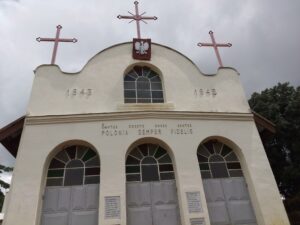
The settlement at Kojja in Mukono district was bigger but razed to the ground after the Poles left. Other settlements in Masindi have also, over the years, gotten destroyed, with the one at Nyabyeya being the only one still standing for those wishing to trace this history with its sturdy housing structures that have weathered the heat and storms and stood the test of time.
When the Poles returned home, the houses were taken over by the locals and refugees from the DRC, while other structures were occupied by the government-owned Nyabyeya Forestry College, which took over the houses as classrooms and staff quarters to date.
The Polish refugees are regarded as the pioneers of Nyabyeya Forestry College, the only forestry college in East Africa by then.
“While here, they used to teach the local children how to pray in Polish. They also had a carpentry workshop where they learned how to do carpentry, and it’s in the buildings of this workshop that the present Nyabyeya Forestry College still operates from. Most of the buildings are still strong and original as they were built by the Poles, though new ones have been built by the government and others renovated,” Karungi says.
Religious tourism
With Uganda looking at diversifying its tourism packages away from wildlife, attracting people to visit religious sites for religious, historical, educational, or research purposes can go a long way in achieving this diversification in a sector that is expanding.
The country has a number of significant religious sites, like the Namugongo martyrs shrine, which attracts hundreds of thousands of pilgrims every year from Uganda and beyond; Lubaga Cathedral; St. Paul’s Cathedral in Namirembe; the Gaddafi mosque; the Baha’i Temple; Mackay’s Cave in Nateete; and the Prayer Palace in Nebbi, which is said to have the smallest church in the world.
Nyabyeya heritage site, however, remains one of the less known heritage and religious sites, but the active links with Poland have ensured that it remains well maintained. According to Karungi, in 2018, the ambassador of Poland to Uganda and Kenya and officials from the Ministry of Culture and Heritage of Poland visited the site to suggest ways of preserving, developing, and conserving it.
“We need the government to further develop the site because it has great tourism potential. While here, visitors can visit the Polish church, cemetery, existing camps, Polish twin houses, the ancient fuel pump used by the Poles, the carpentry workshop, Polish water points, and Nyabyeya Forestry College. Preserving and promoting it for tourism will greatly benefit our district and the local people,” Karungi says.
Away from the history and ancient architecture at the site, the Royal Mile of the Obukama bwa Bunyoro, which is only a few meters away, winds up the visit to this site.
This mile-long forest road opens with a simple gate before sloping gently towards the River Sonso in the middle of an expansive, natural symphony of hardwood trees rising above the ground in what comes off like competition for the skies.
This makes the Royal Mile one of the most ideal places to have a guided birding tour with bird species such as kingfishers, lemon-bellied crombecs, grey-headed sunbirds, woodpeckers, African crowned eagles, and hornbills, among others.
Additional reporting by The Observer
Do you have an advertisement or article you want to publish? Mail us at theugreports@gmail.com or WhatsApp +256757022363.



